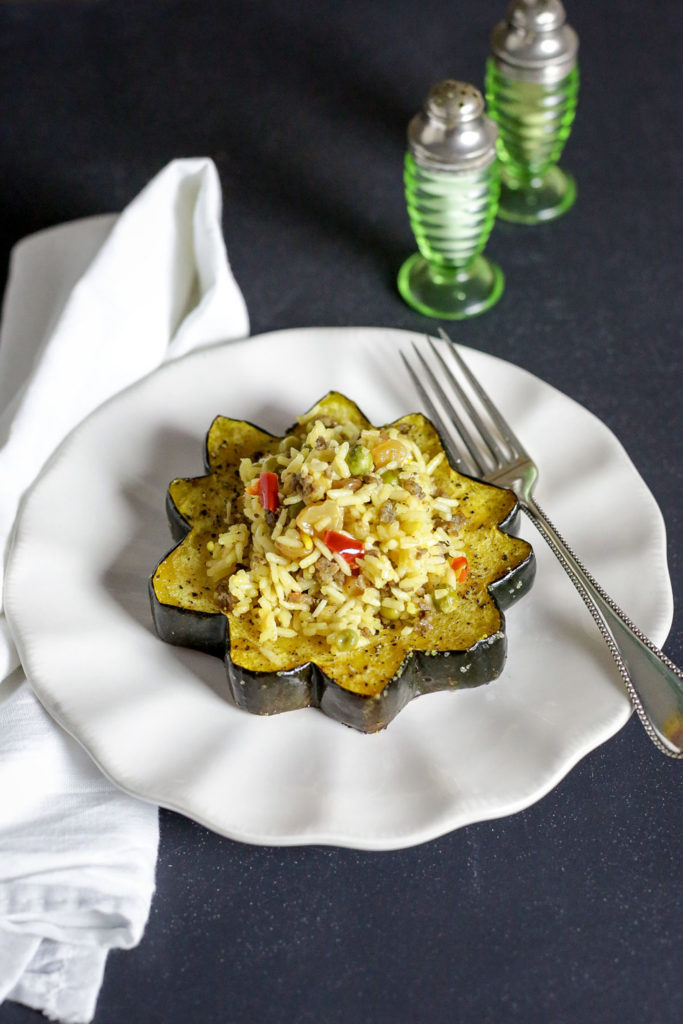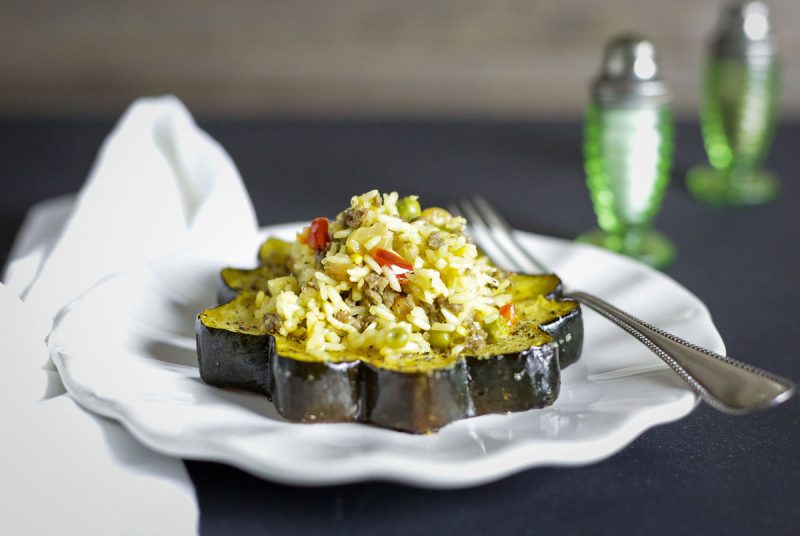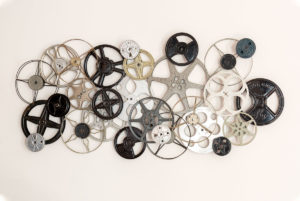If your fall menu doesn’t include roasted acorn squash, I beg you to reconsider. These little beauties are as tasty as they are cute. Low in the bad stuff and high in vitamins and fiber, acorn squash is a healthy hit that is also ridiculously simple to prepare. Pair it with our Monday mashup of dirty rice and rice pilaf and you’ve got a winner on your hands.
I wanted to stuff the acorn squash with rice, but I couldn’t decide between a classic pilaf or dirty rice. So… you got both. I’ve combined my classic pilaf recipe method with some of the spiciness of dirty rice. The combination of thyme and sausage with the subtle sweetness of raisins and orange is unexpected and delicious. This dish would serve nicely as a starch course or entrée for a more casual meal.
savour… greater than the sum of its parts
ROASTED ACORN SQUASH WITH DIRTY RICE PILAF

Before you start:
Acorn squash can be tough to cut. If you don’t mind it changing the presentation slightly, consider making a slice on the side to keep it flat while you cut.
The skins are completely edible (and delicious).
If you lean more toward the dirty side, add a little extra cayenne and maybe even an extra bay leaf or two.
You can use fresh peas here if you like, but they aren’t always easy to find and even if you do have them, it’s a lot of extra work. What you cannot do is use canned peas. That would be a mistake.
Die-hard dirty rice fans may scoff at the omission of giblets. Look, I get you… and I like a visceral organ as much as the next guy, but I made this to serve to my kids, and for them, chicken guts are out.
Use a fork to fluff the rice. If you use a spoon, you might just as well be using a brick.
My usual recipe for pilaf includes chopped pistachios for garnish and I fully intended to add them to this recipe (you should), but when I went to the pantry for them, I remembered that they had fallen victim to a snack attack.
The ingredients:
- 2 tablespoons olive oil
- 2 tablespoons butter
- ½ medium onion, diced
- 2 cloves garlic, minced
- ½ medium red bell pepper, diced
- 2 cups long-grain white rice
- ½ pound pork sausage
- ½ ground beef
- ¾ teaspoon salt + more to taste
- ½ teaspoon black pepper + more to taste
- ¼ teaspoon red cayenne pepper
- 1 teaspoon dried thyme leaves
- ¼ cup golden raisins (learn about raisin basics)
- ½ cup frozen peas, thawed
- 3 cups chicken stock (learn how to make chicken stock)
- 2 bay leaves
- 1 strip of orange zest (about 1”x2”)
- pinch saffron steeped in 1/4 cup of hot water
- 2 acorn squash
The method:
- Preheat oven to 350˚F.
- Add butter and oil in a medium skillet. Melt butter over medium heat. Add onion, garlic, and red bell pepper. Cook until onions are soft and translucent (about 7 minutes). Place rice in a fine-mesh strainer and rinse thoroughly until water runs clear. Place rice in a 9”x13” casserole dish. Pour onion/butter mixture over the rice and stir to coat the rice completely. Set aside.
- Add sausage and ground beef to the skillet over medium heat. Brown the meat slightly, then add salt, pepper, cayenne, and thyme. Brown completely, drain excess fat and add meat to the casserole dish. Add peas and golden raisins to the casserole dish
- Place stock, bay leaves, orange zest, and saffron tea to a medium saucepan over high heat. Bring the mixture to a boil, then reduce heat to simmer for 5 minutes. Pour the stock mixture (including the bay leaves and zest) over the rice mixture and stir mix completely. Immediately cover tightly with aluminum foil. Place in the oven and bake for 35-40 minutes. Remove from the oven and place it on the counter for at least 15 minutes before removing the foil.
- Increase oven temperature to 425˚F. While it is heating, wash and cut acorn squash into 1-inch rings, removing the seeds. Place the rings on a parchment-lined baking sheet and drizzle with olive oil. Rub the oil all over each squash ring. Sprinkle salt and pepper over both sides of each ring. Roast for 30-35 minutes or until the surface is golden brown and flesh is soft and tender.
- To serve, place an acorn ring on a plate. Remove the foil from the pilaf and remove the bay leaves and zest. Fluff the pilaf with a fork, then fill each ring with pilaf.








